
This year, I was able to go to San Juan, Puerto Rico for a conference. This would be my first trip to the Caribbean, and my second trip off the North American continent.
Although the conference hosts expected us to ride
around in taxis everywhere, of course
I just had to find out about public transit.
There wasn't a lot of information out,
but I was able to find out this much:
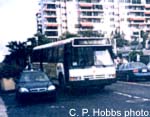 No "chicken buses" here! AMA (Autoridad Metropolitana de Autobuses, or Metropolitan Bus Authority) runs modern equipment (40' TMC RTS II's, and a few Flxibles, exactly like city buses in any large US city) around the more heavily populated sections of San
Juan.
No "chicken buses" here! AMA (Autoridad Metropolitana de Autobuses, or Metropolitan Bus Authority) runs modern equipment (40' TMC RTS II's, and a few Flxibles, exactly like city buses in any large US city) around the more heavily populated sections of San
Juan.
The bus service has been recently restructured, and there are now 32 routes. Each route has a number such as #A3, #B21, etc. There is a numbering system:
- "A" routes are the major trunk routes. These run at least every 7-10 minutes during on weekdays. Night and Saturday service runs about every 15 minutes, with 20-minute headways provided on Sundays and holidays.
- "B" routes run less frequently: every 20 minutes during weekdays, 30-minutes otherwise.
- "C" routes are the most infrequent, running every 30 minutes (60-minutes on Sundays and holidays).
The good news:
- The fare is a whopping 25 cents. (10-cents for seniors and disabled)
The bad news:
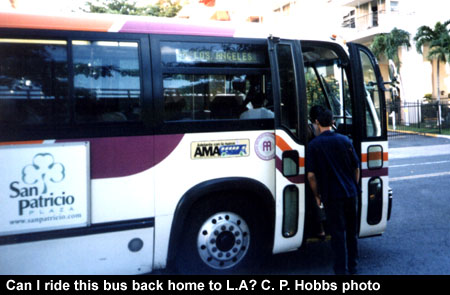
- There are no free transfers between routes. (At 25-cents a ride, I'm not complaining!)
- There don't seem to be any passes, or other discounts. (at least I never saw anyone board with anything that looked like a pass)
- There are no printed schedules, maps or other passenger information. Schedules are posted at each stop, and maps are posted at major transfer points, occasionally on buses, and on the Internet.
- There are no timepoints along the routes; posted schedules just show the last trip of the day and running times.
- Service ends rather early; with the last trip leaving around 10 p.m on major routes. Some lines quit running as early as 8 p.m.
- Headsigns (which are electronic) flash the destination of every neighborhood served by the route, in the same order, so they are not necessarily indicative of the direction of travel, or the ultimate destination of that particular bus run.
Metrobus
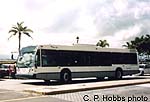 Metrobus is a separate company, or at least operates like one. They run new Nova LFS buses on three routes:
Metrobus is a separate company, or at least operates like one. They run new Nova LFS buses on three routes:
- #1: Old San Juan-Santurce-Hato Rey-Rio Piedras
- A version of the above route, with a freeway-express segment through the Santurce area. This operates on weekdays only
- #2: Santurce-Hato Rey-San Patricio-Bayamon
Fares are also $.25, except for the express which is $.50.
Old San Juan Trolley
 Neither AMA or Metrobus go any nearer to Old San Juan than the main bus station (Terminal Covadonga, located at Calle Marina and Calle Gen. Pershing, just east of Old San Juan proper). However, there is a fare-free "trolley" (actually a bus disguised as a
San Francisco cable car) that runs on two routes through the narrow San Juan streets. The two routes also serve a couple large parking lots (one near the bus station, the other on the waterfront) and are designed to provide an alternative to parking with
in San Juan itself.
Neither AMA or Metrobus go any nearer to Old San Juan than the main bus station (Terminal Covadonga, located at Calle Marina and Calle Gen. Pershing, just east of Old San Juan proper). However, there is a fare-free "trolley" (actually a bus disguised as a
San Francisco cable car) that runs on two routes through the narrow San Juan streets. The two routes also serve a couple large parking lots (one near the bus station, the other on the waterfront) and are designed to provide an alternative to parking with
in San Juan itself.
Carros Publicos
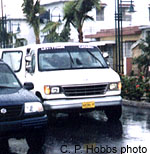 These are privately owned taxi cabs or
15-passenger vans that run on more or less fixed routes,
supplementing the bus service.
All Carros Publicos are specially licensed.
They mostly run in the heavily-populated central part of San Juan,
but can be occasionally seen in more distant suburbs.
I didn't use these, so I don't know what the fares are (probably not over $1 for
local trips, though).
These are privately owned taxi cabs or
15-passenger vans that run on more or less fixed routes,
supplementing the bus service.
All Carros Publicos are specially licensed.
They mostly run in the heavily-populated central part of San Juan,
but can be occasionally seen in more distant suburbs.
I didn't use these, so I don't know what the fares are (probably not over $1 for
local trips, though).
Carros Publicos also provide intercity service as well, say from San Juan to Ponce (on the south side of the island), Farjardo (on the east coast, for ferries to Vieques and Culebras), Mayaguez (ferry to Dominican Republic) and other cities. (There doesn't seem to be a more formalized, Greyhound-type intercity service in Puerto Rico, or at least I saw no evidence of one)
AcuaExpreso
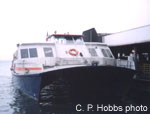 The Port Authority of Puerto Rico operates three ferry routes:
The Port Authority of Puerto Rico operates three ferry routes:
- Old San Juan-Cataño
- Old San Juan-Hato Rey
- Cataño-Hato Rey
Fares are $.50 per trip. Service is rather frequent during the day (every 30-min or better), and runs until about 10 p.m. or so. The ferries leave Old San Juan from Dock (Muelle) 2.
The ferries are small boats, maybe about 2/3rds the size of the Vancouver Seabus. They are catamarans and are quite fast (the crossing between San Juan-Cataño takes about 15 minutes or less).
Under construction and due to open sometime in 2002, this mostly-elevated rail system will run on a "J" shaped route connecting Bayamon (suburb southwest of central San Juan) with Hato Rey (central San Juan); an extension to Santurce (going toward, but no
t entering Old San Juan) may open later.
Note: Another good overview of the transit system in San Juan can be
found at
http://www.cga.state.ct.us/2001/rpt/olr/htm/2001-r-0091.htm
The trip report
After a long overnight flight between LAX and Fort Lauderdale, and an hour's layover, I caught my connecting flight to SJU. The flight was uneventful, except the landing seemed to be a little more steep than normal (one passenger told me it was because the pilot was trying to avoid the "Bermuda Triangle" or flying over Cuba). Everybody applauded when we landed.
Not quite sure of the transit options (the AMA web site had not been updated at that time), I paid $8 for a cab to my hotel. (Later I found out that there was pretty good bus
Service to the airport, although I would have had to change buses one time to get to the hotel). My ears were still buzzing a bit from the plane ride, so I took a short nap, then got up and walked along Isla Verde Av.
Isla Verde Av is the resort area of San Juan (actually a suburb called Carolina). It has a mixture of high-rise hotels, fast food restaurants, liquor stores, a souvenir shop or two, and a cemetery. Beware, there are not a lot of good places to cross the s
treet (i.e. signalized intersections). People just dart across into oncoming traffic...
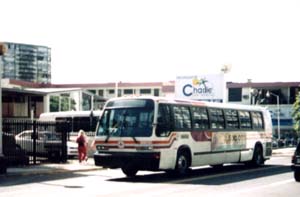 A little bit later that day, I decided to try the bus system. I had an idea that the #A5
(the route along Isla Verde) eventually ended up in Old San Juan. Of course, I didn't know exactly what route it would take, or how long, but I figured if things got too hairy looking, I could always just ride it back...
A little bit later that day, I decided to try the bus system. I had an idea that the #A5
(the route along Isla Verde) eventually ended up in Old San Juan. Of course, I didn't know exactly what route it would take, or how long, but I figured if things got too hairy looking, I could always just ride it back...
The bus pulled up, and I, along with a few other people at the stop, boarded. It was late afternoon, around 5 p.m. on a Friday, and the bus was moderately crowded with locals and a few tourists. We traveled along the tourist area of Isla Verde, then took
a left turn into a rougher-looking neighborhood.
We passed through a huge housing project (Llorrens Torres), full of yellow and blue buildings with bars on the windows. The bus got really full here, and also along Calle Loiza (a street which sort of reminded me of the South Side of Chicago for some reason). We then drove along the somewhat more upscale Avenida de Diego and Calle Ponce de Leon, and then the "Carril Exclusivo" (a special bus- and taxi only street). The bus route ended at a large bus terminal just outside of Old San Juan. I got off, walked
around for about an hour, taking in the sights (it was fully dark then), then got back on the #A5 and rode back to the hotel. It took about 45 minutes or so each way.
The next day (Saturday, December 1), I rode the #A5 to Old San Juan again. The trip was about the same as the day before, only it was daytime and I could see more of what I passed through. Also, near old San Juan, there was a big traffic jam around the cruise ship area just before we got to the bus terminal.
I walked around the narrow streets of Old San Juan, and visited the fort
(El Castillo San Felipe del Morro). The historic fort costs $2 to enter, and is fun to
walk around for an hour or two.
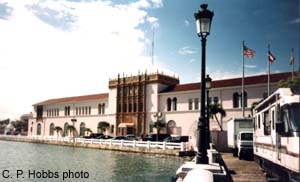
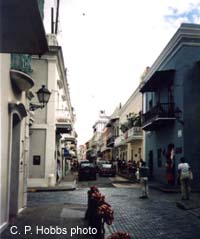
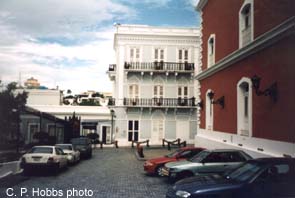
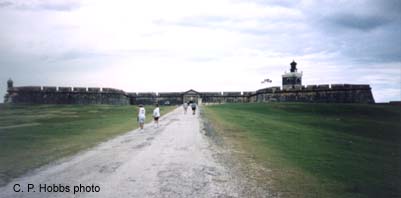
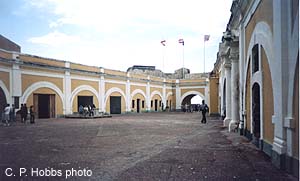
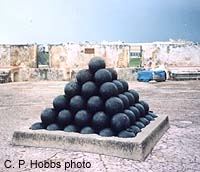
By the time I left the fort, (about 1 p.m.)
it had started raining a little, and fifteen minutes later
it was a downpour, with thunder and lightning, before I got back to the waterfront.
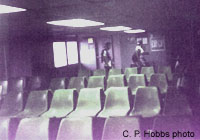 I caught an AcuaExpreso ferry (50-cents) and rode it across the bay to Cataño. These boats, as one of my program hosts later told me, are simply basic transportation for the people living across the bay. Indeed, the hard seats and floors, (as well
as all the kids chattering) gave the boat a real schoolbus feel.
I caught an AcuaExpreso ferry (50-cents) and rode it across the bay to Cataño. These boats, as one of my program hosts later told me, are simply basic transportation for the people living across the bay. Indeed, the hard seats and floors, (as well
as all the kids chattering) gave the boat a real schoolbus feel.
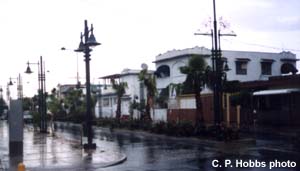 Cataño consisted of a few houses,
a bar where guys watched a plugged-in TV set outside
in the rain(!), and a promising looking restaurant.
There was a small (and full) parking lot by the ferry terminal,
further emphasizing the "commuter" function of these boats.
The crowd outside the ferry terminal slowly dispersed
as they went to their cars, got picked up,
or simply walked home in the rain.
Cataño consisted of a few houses,
a bar where guys watched a plugged-in TV set outside
in the rain(!), and a promising looking restaurant.
There was a small (and full) parking lot by the ferry terminal,
further emphasizing the "commuter" function of these boats.
The crowd outside the ferry terminal slowly dispersed
as they went to their cars, got picked up,
or simply walked home in the rain.
(By the way, the Barcardi distillery is not too far away and can be accessed
by bus, carro publico or taxi from the ferry terminal)
My original plan was to take the #A3 bus to Hato Rey, then catch the #A6 to Iturregui, and finish up with the #A5 back to Isla Verde. But I wasn't able to locate the #A3 stop, just the one for the #C37 to Levittown. (The #A3 stop probably wasn't all that
far away, but I wasn't quite up to looking for it in all that rain. So I just took the next ferry back to San Juan. On arrival, there was an enormous crowd waiting for the ferry to Cataño.
I walked over to the bus station and boarded an #A5. It took forever to get through the
traffic-choked area near the cruise ships. Also the bus filled to standing-room only by the time we got on the bus lanes;
people were boarding via the back doors along Calle Loiza.
Most of this ridership got off in or around the Llorrens Torres housing project.
This was basically the end of my explorations, as an all-day meeting (and lots of rain) made Monday a day spent inside the hotel for the most part.
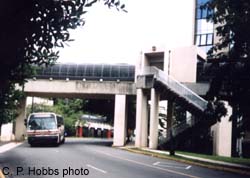 On Tuesday we took cabs to the
University of Puerto Rico
Medical Sciences Campus
for presentations and a campus tour. The campus reminded me a little bit
of the USC Health Sciences campus, located in East LA near the County Hospital.
(The Tren Urbano, when completed,
will have a stop near the south end of campus. Also, the
AMA offices, and probably the bus yard, are not too far away,
but I didn't get a chance to go near any of those facilities).
The cab from the Medical Sciences Campus to the airport cost $20-again, if I had had more bus information, I would have been able to get there by catching bus #B4 or #B52 to Rio Piedras, then #B40 to the airport. (Probably faster too, as the #B40 uses
a toll bridge across the Laguna San Jose that the cabbies avoid).
On Tuesday we took cabs to the
University of Puerto Rico
Medical Sciences Campus
for presentations and a campus tour. The campus reminded me a little bit
of the USC Health Sciences campus, located in East LA near the County Hospital.
(The Tren Urbano, when completed,
will have a stop near the south end of campus. Also, the
AMA offices, and probably the bus yard, are not too far away,
but I didn't get a chance to go near any of those facilities).
The cab from the Medical Sciences Campus to the airport cost $20-again, if I had had more bus information, I would have been able to get there by catching bus #B4 or #B52 to Rio Piedras, then #B40 to the airport. (Probably faster too, as the #B40 uses
a toll bridge across the Laguna San Jose that the cabbies avoid).
Anyway, I got to the airport two hours early, as recommended,
but I probably could have gotten away with getting there about
an hour before flight time.
The flight segment between San Juan and Miami had about 12 people on it, and the MIA-LAX segment was slightly more crowded (anyone who really wanted it could have their own row of seats). I made back to LAX around 10 p.m, and back home (via Van Nuys Flyaway bus) around 11:30.
Transit|
Home Page
 A little bit later that day, I decided to try the bus system. I had an idea that the #A5
(the route along Isla Verde) eventually ended up in Old San Juan. Of course, I didn't know exactly what route it would take, or how long, but I figured if things got too hairy looking, I could always just ride it back...
A little bit later that day, I decided to try the bus system. I had an idea that the #A5
(the route along Isla Verde) eventually ended up in Old San Juan. Of course, I didn't know exactly what route it would take, or how long, but I figured if things got too hairy looking, I could always just ride it back...

 No "chicken buses" here! AMA (Autoridad Metropolitana de Autobuses, or Metropolitan Bus Authority) runs modern equipment (40' TMC RTS II's, and a few Flxibles, exactly like city buses in any large US city) around the more heavily populated sections of San
Juan.
No "chicken buses" here! AMA (Autoridad Metropolitana de Autobuses, or Metropolitan Bus Authority) runs modern equipment (40' TMC RTS II's, and a few Flxibles, exactly like city buses in any large US city) around the more heavily populated sections of San
Juan.

 Metrobus is a separate company, or at least operates like one. They run new Nova LFS buses on three routes:
Metrobus is a separate company, or at least operates like one. They run new Nova LFS buses on three routes:
 Neither AMA or Metrobus go any nearer to Old San Juan than the main bus station (Terminal Covadonga, located at Calle Marina and Calle Gen. Pershing, just east of Old San Juan proper). However, there is a fare-free "trolley" (actually a bus disguised as a
San Francisco cable car) that runs on two routes through the narrow San Juan streets. The two routes also serve a couple large parking lots (one near the bus station, the other on the waterfront) and are designed to provide an alternative to parking with
in San Juan itself.
Neither AMA or Metrobus go any nearer to Old San Juan than the main bus station (Terminal Covadonga, located at Calle Marina and Calle Gen. Pershing, just east of Old San Juan proper). However, there is a fare-free "trolley" (actually a bus disguised as a
San Francisco cable car) that runs on two routes through the narrow San Juan streets. The two routes also serve a couple large parking lots (one near the bus station, the other on the waterfront) and are designed to provide an alternative to parking with
in San Juan itself.
 These are privately owned taxi cabs or
15-passenger vans that run on more or less fixed routes,
supplementing the bus service.
All Carros Publicos are specially licensed.
They mostly run in the heavily-populated central part of San Juan,
but can be occasionally seen in more distant suburbs.
I didn't use these, so I don't know what the fares are (probably not over $1 for
local trips, though).
These are privately owned taxi cabs or
15-passenger vans that run on more or less fixed routes,
supplementing the bus service.
All Carros Publicos are specially licensed.
They mostly run in the heavily-populated central part of San Juan,
but can be occasionally seen in more distant suburbs.
I didn't use these, so I don't know what the fares are (probably not over $1 for
local trips, though).
 The Port Authority of Puerto Rico operates three ferry routes:
The Port Authority of Puerto Rico operates three ferry routes:






 I caught an AcuaExpreso ferry (50-cents) and rode it across the bay to Cataño. These boats, as one of my program hosts later told me, are simply basic transportation for the people living across the bay. Indeed, the hard seats and floors, (as well
as all the kids chattering) gave the boat a real schoolbus feel.
I caught an AcuaExpreso ferry (50-cents) and rode it across the bay to Cataño. These boats, as one of my program hosts later told me, are simply basic transportation for the people living across the bay. Indeed, the hard seats and floors, (as well
as all the kids chattering) gave the boat a real schoolbus feel.
 Cataño consisted of a few houses,
a bar where guys watched a plugged-in TV set outside
in the rain(!), and a promising looking restaurant.
There was a small (and full) parking lot by the ferry terminal,
further emphasizing the "commuter" function of these boats.
The crowd outside the ferry terminal slowly dispersed
as they went to their cars, got picked up,
or simply walked home in the rain.
Cataño consisted of a few houses,
a bar where guys watched a plugged-in TV set outside
in the rain(!), and a promising looking restaurant.
There was a small (and full) parking lot by the ferry terminal,
further emphasizing the "commuter" function of these boats.
The crowd outside the ferry terminal slowly dispersed
as they went to their cars, got picked up,
or simply walked home in the rain.
 On Tuesday we took cabs to the
On Tuesday we took cabs to the